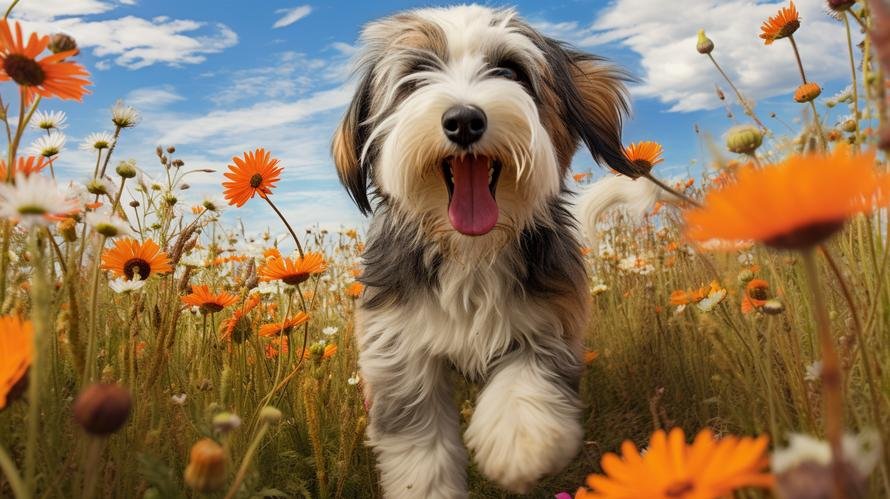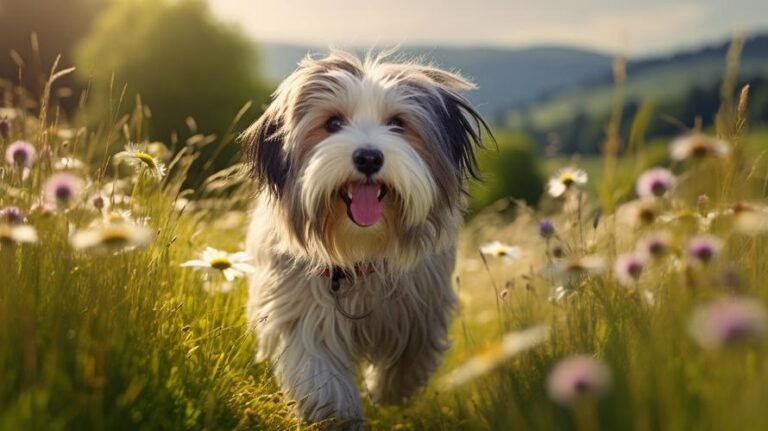Let’s start off with a fun fact – Despite bearing the name ‘Tibetan Terrier’, this breed is not a terrier at all. In fact, it was European explorers who coined the term due to the breed’s size and terrier-like appearance. These fluffy, affectionate creatures are more closely related to herding dogs. They hail from the lofty peaks of Tibet, where they served as faithful companions to the Buddhist monks in isolated monasteries. Once considered bringers of luck, the Tibetan Terrier has transitioned from watchdogs and companions in isolated mountainous regions to beloved family pets around the globe.
Now that we’ve broken the ice and have a little background about the Tibetan Terrier let’s talk about the shedding. The question ‘Does a Tibetan Terrier shed a lot?’ is a fairly common one among potential dog owners and those that are interested in welcoming this unique breed into their home. So, let’s dive in and find out the answer to this all-important question.
The Tibetan Terrier has a thick double-coat that’s often described as wooly or sheep-like. But here’s the twist – unlike many other breeds with a similar double coat, Tibetan Terriers do not shed much at all. Isn’t that a pleasant surprise? Before you start celebrating, though, there’s a bit more you need to know.
A Tibetan Terrier’s fur grows continuously, much like human hair. This means they do not have seasonal shedding periods like many breeds. Instead, they lose hair just as humans do—as individual strands reach the end of their life cycle, they fall out, making way for new strands to grow. Another term for this process is ‘hair cycle’. However, they do have a ‘blowing coat’ phase, which typically occurs during the first two years. During this period, they shed more intensively, as their puppy coat makes way for adult fur.
This lack of heavy shedding does not mean that Tibetan Terriers require less grooming, though. Quite the opposite, actually. Their coat tends to mat and tangle, which means they demand regular brushing and grooming to avoid a matted and uncomfortable dog.
Here’s a bit of advice – aim to brush your Tibetan Terrier at least once a week, and more if possible. Regular brushing will not only prevent mats and tangles, but also promote healthy coat and skin by distributing natural oils. Since they have hair in their ears, regular ear cleaning is necessary to prevent infections. A professional groomer can help keep the coat and skin healthy and the dog comfortable.
Also, a quick grooming tip: some owners opt to keep their Tibetan Terriers’ fur trimmed short, while others prefer the long and flowing look. It’s important to remember that even if kept short, their coat requires regular care.
However, if you’re allergic to dogs, a Tibetan Terrier could be a good choice. They are often considered hypoallergenic due to their fur-like coat. But remember, hypoallergenic doesn’t mean allergy-free; it just means less likely to trigger allergies. Always spend time with a dog of this breed before bringing one into your home if you have allergies.
In conclusion, the Tibetan Terrier is a breed that’s perfect for those who don’t mind investing time in grooming but would prefer to avoid the major shedding seasons. Their companionship, affection, and slightly mischievous personality make them worth every moment spent behind a brush. With the right care, the Tibetan Terrier is not just a pet but an adorable, fluffy member of your family who brings joy, happiness, and not a lot of loose hair! So, if you value your black clothes and don’t have hours to spend vacuuming, this could be the dog breed for you! Just be prepared for grooming time and lots of love from your new Tibetan Terrier friend.
In the grand scheme of things, a bit of fur on the couch is a small price to pay for the unwavering love and companionship that a dog brings into our homes. So, whether adorned in a long, flowing coat or a practical, shorter clip, your Tibetan Terrier is sure to bring you a tale of joy without the fur-tale of constant sheddings.



